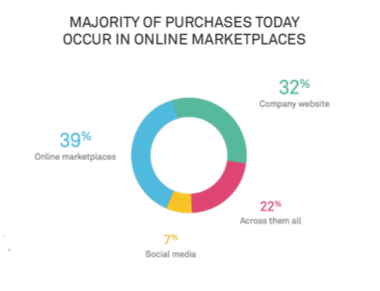
Ecommerce and Retail • Neto

It’s easier than ever to open up your online store and access a whole new market of shoppers eager to find the best prices and make their purchases from the comfort of their own homes…or workplaces, or on public transport, or even while standing in your competitor’s shop. That’s one of the things that makes an online store such an attractive retail venue both for brand new online-only businesses and established bricks-and-mortar retailers. And for many retailers, ecommerce is synonymous with “having an online store”.
But ecommerce is about much more than one online channel. You can also sell through mobile apps, social media sites, and some of the most popular retail venues for Australian online shoppers: marketplaces, like eBay and Amazon. Our survey with Telstra showed that adding these extra sales channels can increase the number of online shoppers you connect with by up to 85%, leading to sales growth and a boosted bottom line.
This is probably easiest to understand if we look at it from the perspective of a bricks and mortar retail store—a convenient analogy. If you’ve effectively targeted your niche —selling the right products at the right price while offering a great customer experience — then prospective customers are going to find you wherever you hide. That’s your online store: a place where keen customers can reliably find what they’re looking for, and where prospective customers can get to know your brand and products.
But your location matters when it comes to converting customers who don’t know you yet. Humans are creatures of habit, so you’ll have to go above and beyond to tempt them away from their current favourite retailers. You need to be visible, and while a targeted marketing campaign will help with that, nothing works quite like being where the shoppers are likely to find you.

That means setting up shop in the nearest Westfield, rather than a quiet backstreet. Or, in the ecommerce world, setting up your eBay store. Once you’ve set up your store on eBay or another marketplace, your prospective customers will see your prices listed alongside your competitors’—much like being in the same shopping mall—and they’re more likely to check out what you’re offering.
Everyone. We’re not kidding—if you don’t, you’ll miss out on connecting with the 39% of Australian shoppers who shop exclusively in marketplaces, and you’ll be less likely to convert the 22% who shop across multiple channels.

If we haven’t yet persuaded you, try searching on eBay for a few of the items your store sells. The search results you see? Those sellers are your competitors, and they’ve got access to a target audience you’re currently not catering for.
Not if you do it wisely! We recommend using an omni-channel retail platform that can manage your eBay store, your other ecommerce channels, and any physical points of sale, all in the one system—a platform like Neto. Look for a platform that will streamline your operations with ready-built eBay integrations to help
This approach enables retailers to reach the wider audience on eBay without the inconvenience of setting up another channel from scratch and without the difficulty of managing your business across multiple platforms.
You bet. Around 60% of Neto’s customers have already become eBay PowerSellers based on their consistently high sales and positive feedback scores. In addition to seeing the benefits of higher sales and great customer reviews, they’re also getting a reward of direct savings from eBay.
No, but it is currently the key marketplace for Australian shoppers. That might all change once Amazon opens, though. They haven’t announced the launch date, but it’s expected to happen in the next couple of months.
Our survey with Telstra showed that one in three online shoppers—especially those looking for electronics and hi-fi equipment, clothing and fashion items, and gifts—plan on making the switch to Amazon. Some smaller retailers may even struggle to compete, unless they build an Amazon store as an additional sales channel.

Neto is currently in the final stages of integrating our ecommerce platform with Amazon, which will make it just as easy to open and manage your Amazon store as it is to open your eBay store.
In this post, we’ve only touched on a few of the channels you can expand into as you grow your ecommerce empire. To fully understand the potential of an omni-channel strategy, and what it can do for your business, check out our ultimate guide: Sell Everywhere.
Neto is the only Australian retail management platform that provides a complete solution for ecommerce, point of sale, inventory, and fulfilment. Our integrated back-end technology enables exceptional and consistent customer experiences via any channel, be it in-store, online or through a marketplace. We automate repetitive tasks and integrate with multiple sales channels to manage orders and shipments.